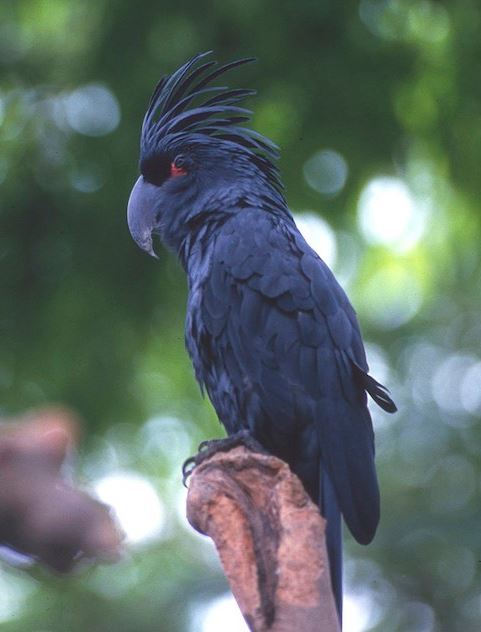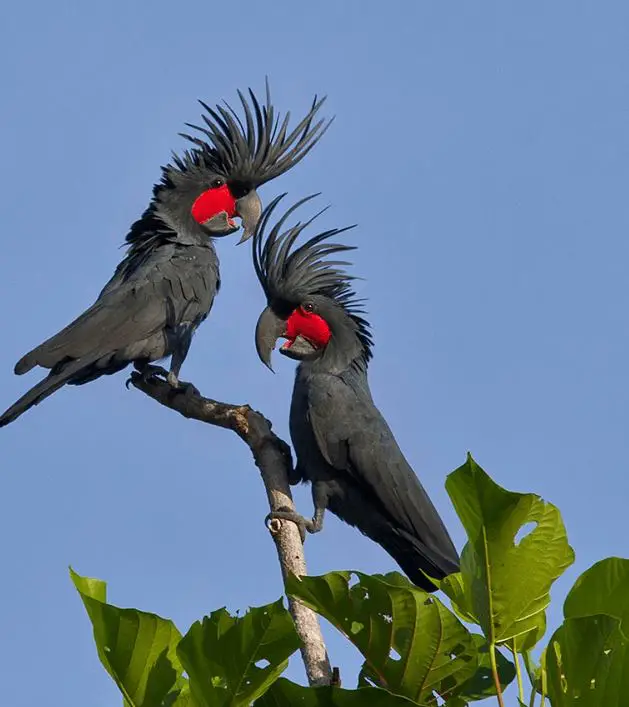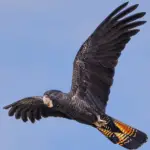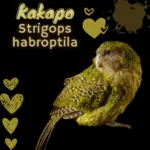
Goliath Cockatoo: 51–64 cm (1); 550–1000 g. Generally with naked scarlet cheek patches and long, backward-curving red, tongue red with black tip; massive bill grey-black, with upper mandible 94 mm long in male, 74 mm in female; eye dark brown; legs grey to black with bare grey thighs.
The Female also has smaller cheek patches. Immature has feathers of underparts and underwing-coverts edged pale yellow, as well as a white tip to bill (lost after c. 18 months) and eyering, with paler pink facial skin.
goliath palm cockatoo
Systematics History
Internal taxonomy uncertain; phylogeographical study identified two main clades: one in W, corresponding approximately with race goliath; and the other in E,
where small genetic differences among populations render delimitation of races very difficult and perhaps unreliable; present arrangement provisional, pending further investigation.
Proposed race Alecto (W Papuan Is) is here included within goliath; form intermediate (Aru Is) is a synonym of nominate.
The original type locality of species is probably based on faulty citation of Latham referring to another species of cockatoo. Four subspecies are tentatively recognized.
Subspecies
Introduced (possibly nominate race) to Kai Is, in SE Moluccas.
SUBSPECIES
Probosciger aterrimus stenolophus Scientific name definitions
Distribution
N and E New Guinea (from Mamberamo R E to Collingwood Bay) and Yapen I (in Geelvink Bay).
Identification
Larger than nominate, with narrower crest feathers.
SUBSPECIES
Probosciger aterrimus goliath Scientific name definitions
Distribution
W Papuan Is (except Misool), and W, C (except S Trans-Fly) and SE New Guinea.
Identification
Larger than nominated.
SUBSPECIES
Probosciger aterrimus aterrimus Scientific name definitions
Distribution
Aru Is., Misool I., s New Guinea and in Australia (Cape York)
Australian Black Palm Cockatoo

Black Palm Cockatoo
In New Guinea, frequents rainforest, gallery forest, forest edges, partly cleared areas, tall secondary forest, monsoon woodland, and, locally, dense savanna. Mostly in lowlands and hills up to 1350 m, but commonest below 750 m.
On the Cape York Peninsula, frequents fringe zone between lowland monsoon forest and adjacent Eucalyptus woodland, as well as dense savanna and paperbark woodlands. In Australia, most abundant in woodland, rather than rainforest.
Goliath Cockatoo Movement
Territorial pairs are resident in a patch of forest that provides several nest hollows. Pairs may associate together in flocks of up to 30 birds when foraging outside the territory wherever fruiting trees are available but return to roost in their territories at night, where they are intolerant of other conspecifics.
Goliath Cockatoo Diet and Foraging
Like all cockatoos, black palm cockatoos can easily become overweight, so owners should keep a close eye on their fat intake. A healthy diet should include high-quality pellets, a moderate amount of seed mix, and daily servings of fresh, bird-safe fruits and vegetables.
This will mimic their natural diet, and as a result, some nuts in the shell will exercise their beak as well. Keep them to a minimum, as some are high in fat.
Chiefly arboreal feeder, taking seeds, fruits, nuts, berries, and buds from a wide variety of plants, particularly Pandanus palm nuts and Castanospermum Australe; occasionally eats fallen fruits on the ground, especially seeds of Terminalia kaernbachii and Canarium. Nuts are routinely cut in half using the massive bill.
Sounds and Vocal Behavior
Wide variety of calls, all of which are generally higher-pitched than those of Cacatua galerita, while the frequently-uttered bisyllabic whistled contact call is less harsh and grating than in Calyptorhynchus species, with the first note mellow and deep,
the second shrill, high-pitched, prolonged and ending on an abrupt upward-inflection; also more raucous calls including a far-carrying, donkey-like “keeyaank!”, “eeyohn!” or “raah!” and a sharp guttural screeching.
The palm cockatoo can be a good pet, but don’t expect to be as affectionate as many other parrots. They need a lot of attention to tame, although they are very intelligent and social birds if the owner is consistent and can provide the time and attention needed.
It is one of the few bird species that make good use of tools. In their natural habitats, male birds will use a large stick to “drum” against a hollow tree before choosing where to build a nest.
It is said that it can be heard 100 yards away and the stick is broken before it becomes part of the new nest. This behavior still confuses many scientists who study birds.
Although there is no obvious explanation, some people believe that the females listen to the drumming when deciding if this is a suitable nesting site.

Black Palm Cockatoo
Bluey & Mizu: Tribute to Spike the Goliath Black Palm Cockatoo
SOURCE: Bluey & Mizu
Goliath Cockatoo Breeding
Laying recorded Jul–Mar. Pairs are territorial and resident, nesting in hollows high in the trunk of dead or living trees (in Australia, Eucalyptus tetrodonta or Corymbia nesophila and C. clarksoniana are the most frequently used tree species); hollow is lined with freshly shredded twigs and wood chips prepared by both members of pair;
lining sometimes up to 1 m deep. Species build nests in multiple hollows, a subset of which is used for actual breeding whereas the rest are used only for display purposes.
Both partners have been seen to give a spectacular drumming display at nest-hollow, using a specially prepared stick or Grevillea glauca nut as a tool; drumstick is held in foot and beaten against the hollow trunk.
Usually, one white egg; incubation c. 30–35 days by female, which is fed by male; hatchling naked, not downy as in other cockatoos; nestling remains in the hollow for 100–110 days and is fed by the female; in captivity, fledging 78–81 days.
On fledging, young cockatoo remains with their parents until the next nesting season approaches and continue to be fed by adults for c. 6 weeks after leaving the nest.
Nest success 22% in N Australia in 1999, but 40% in Crater Mountain (Papua New Guinea); major nest predators include varanid lizards (Varanus spp.), giant white-tailed rats (Uromys caudimaculatus), Black Butcherbirds (Melloria quoyi), and amethyst pythons (Morelia amethistina).
Furthermore, the reproductive rate is very slow, as females in Iron Range National Park, on the Cape York Peninsula, only breed on average every 2·2 years.
Goliath Cockatoo Price
black palm cockatoo cost: These rare birds can cost upwards of $15,000.
Black Palm Cockatoo Colors and Markings
The black palm cockatoo is a very dark, smoky gray color that appears blacker in some birds than in others. The same color appears on their very long crest, as well as on their feet and legs.
This otherwise one-colored bird has bright red patches of bare skin on its cheeks, which change color when the bird is excited. It is as striking as the dark greyish-black beak, giving it a very sharp profile up close.
Somewhat intimidating, their beaks are eclipsed only by the double-crested macaw of the parrot family. The size, shape, and the fact that the upper and lower mandibles do not meet make it perfect for cracking the toughest nuts.
A monomorphic species, there is no visual way to distinguish males from females. If you are curious about the sex of your bird, DNA sexing is necessary.
Black Palm Cockatoo Size
One of the largest cockatoos, the black palm measures between 22 and 24 inches from beak to tip of tail at maturity. A healthy weight for adults is between 2 and 3 pounds.
Black Palm Cockatoo Lifespan
In the wild, this cockatoo is believed to live for 40 to 60 years. As pets, they are claimed to live for 80 to 90 years or more with proper care, although the average for zoos is around 50 years. the lowest reproductive rates among parrots.
are cockatoos good pets
black palm cockatoo for adoption
A Goliath Cockatoo or black palm cockatoo is not a good option for bird owners living in apartments or condominiums. They possess very loud and extremely loud calls, and you (and your neighbors) must be able to tolerate loud noises to live with one.
Black cockatoos should not be left alone for more than eight hours a day. They are therefore not a good choice if you have a normal work schedule or other obligations.
They also need a large cage and plenty of room to play. If you cannot accommodate an aviary of this size, it is best to consider one of the smaller cockatoo species.
Before adopting a black palm cockatoo, contact the breeders to see if you can spend time with them and their birds. Getting to know someone who has bred these special birds before will help you decide if they are right for you.
Make sure you don’t adopt a wild cockatoo, as they usually cannot be tamed. It is a protected species and you will need a CITES to permit to prove its origin in order to own one. Another option is to look for bird rescues, as many owners abandon these birds after realizing there is only a handful.
Don’t be discouraged if you find this bird to be a poor fit. It is better to adopt a bird that you can handle than one whose care will not be satisfied. There are many other cockatoos to choose from.
Conservation Status
Not globally threatened. CITES I. Previously considered Near Threatened. Much sought after for aviary trade, which is illegal in Australia; development of methods to distinguish between Australian and New Guinea Black Palm Cockatoo would help the authorities to police this trade; may be seriously affected by this factor, and listed on CITES I since 1987.
In New Guinea, the extent of lowland rainforest habitat has been notably reduced by logging, which continues. Remains common in Fakfak Mts, SW Irian Jaya.
Status in Australia rated insufficiently known; the ecotone between tropical forest and woodland has been little modified, but more frequent and mismanaged fires late in the dry season may destroy significant numbers of nest-hollows;
a study conducted between 1999 and 2005 focusing on a mean of 48 nest-trees each year found that 26·2% of trees were rendered unusable by the cockatoos due to fire (62·5%), wind (25%), and intense decay,
where the tree was left standing but unusable (12·5%), with on average, 5·2% of nest-trees lost each year of the study; on the other hand, tropical cyclones can be a positive agent for creating nesting habitat.
Like many other parrots restricted in mainland Australia to N Queensland, it is poorly known among the country’s general public, which does not facilitate its conservation.
Species (especially nestlings) hunted for food in New Guinea, and possibly on Cape York too; high rates of nestling predation in Papua New Guinea and low reproductive rate in Australia suggest that in the long term the species is at some risk. Captive-breeding programs in Europe and North America.




















